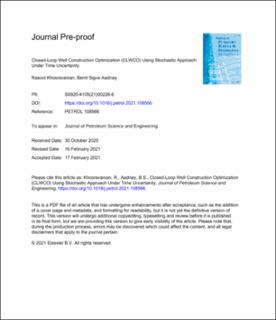| dc.description.abstract | There is a digital step change taking place in well construction today. More and better data will become available for a vast number of analyses. The well construction process is complicated and includes several hundred parameters. There are many inhouse drilling analytics tools used by service and consulting companies. The objective of this paper is to aim at a complete time optimization and to improve health, safety and the environment (HSE) in a time-effective way. In this paper we establish and apply a full approach methodology for closed Loop well construction optimization (CLWCO) under time uncertainty.
CLWCO involves six major steps: data gathering,a work-breakdown structure (WBS) in drilling scenarios, time estimation (budget time &technical time),time simulation (MCS&PERT), scenario analysis & optimization and finally updating time model.
CLWCO involves three major concepts: optimizing the time plan based on current time knowledge, drilling new wells and collecting time data, finally updating multiple time models based on all of the available data. In the CLWCO step, work breakdown structure (W.B.S), time and controls for new wells are optimized by Monte-Carlo Simulation and program evaluation review technique (PERT).
This paper goals are to identify and in best case quantify “the value of Monte Carlo simulation and Program Evaluation Review Technique (PERT) in batch & conventional time drilling optimization” in offshore wells for clients or operating company. Batch drilling does not combine professionally with modern techniques yet.we fill this gap by using modern techniques to optimize and enhance drilling work. We evaluate and analysis above-mentioned approach for batch drilling which has become increasingly prevalent in the petroleum industry as large and small investors alike seek to increase their profit margin. The insight of many of these oil and gas companies was to drill and complete wells using new techniques with the desire of considerable reduction in drilling time and cost for the field. when similar hole sections such as 32″,24″,16″,12 ¼″ and 8 ½″ of different wells were drilled one after the other efficiency and profits would be greatly increased. According to obtained results in closed loop well construction optimization (CLWCO), these methods are successful as it needs less time and cost to drill a lot of wells using the same platform. we simulated a drilling program for the case study of SP field by Monte-Carlo Simulation and program evaluation review technique (PERT),at the end we propose the optimum probable time to do future drilling program in SP field.
The time versus depth graph of drilling project show that the improved drilling efficiency for drilling project designed as 11 wells would reduce the total drilling time around 15% in compare of previous drilling projects in phase SP6,SP7 and SP8,totally average drilling time have been improved between 2.5 and 8 days in MCS and PERT simulation technique for each well by using CLWCO.We presented the optimal plan coupling with batch drilling could be implemented in the future phases of SP field, which has resulted in decreasing drilling time to 30 days by using casing-drilling and liner-drilling technology. | en_US |
